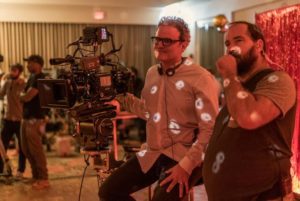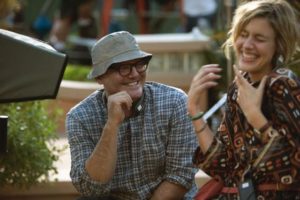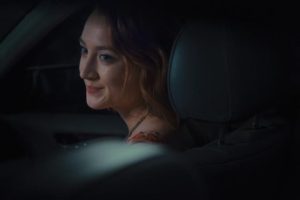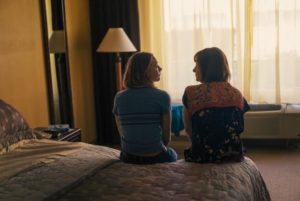
Sam Levy’s naturalistic cinematography, in Greta Gerwig’s directorial debut of Lady Bird is meticulously crafted. The story follows the contentious relationship between Christine ‘Lady Bird,’ a high school senior played by Saoirse Ronan, and Marion, her mother, played by Laurie Metcalf.
Levy and Gerwig had already worked together on Frances Ha, Maggie’s Plan and Mistress America. In fact, Gerwig mentioned the idea for Lady Bird to Levy during the wrap party for Mistress America, where she asked, “I’ve got a project. You don’t have to read it if you don’t want to.” They started working together a few days later, talking about the script, breaking it down and shot listing. According to Levy they were “very much on the same page about what this movie could be, how to shoot it, the philosophy of the aesthetic, and how to go about doing it.”

In their first conversation, Gerwig articulated, “I want this movie to look like a memory. I want the viewer to feel like the movie is over there,” extending her arm as if to say “I’m the viewer, I’m connected to what I’m seeing, but I’m a little removed from it at the same time.” So the next step for Levy was to figure out how to portray the “aesthetic of memory.”Among the films they viewed for visual inspiration were Trufault’s 400 Blows, which had interesting classroom scenes, and Peter Bogdonavich’s Paper Moon. Chantal Ackerman’s Autour de Jeanne Dielman was a reference for the Marion character. Most of the film was shot in Sacrameno, CA, where Gerwig grew up. John Huston’s Fat City, which was shot in Stockton, CA, was a reference for the Sacramento aesthetic.
According to Levy, Gerwig wanted the photography to be “beautiful, but not too beautiful,” and “plain, but luscious.” Gerwig introduced Levy to French photographer Lise Sarfati’s portraits of teenage girls, because they had a “very simple but dense quality to them, almost mundane but really beautiful.” They also looked at the paintings of Wayne Thiebaud, who painted with “great pastel colors, where you can see a lot of the color palette and light of Sacramento.” Levy Xeroxed copies of the visual references from Sarfati and Thiebaud, in addition to screen grabs from several films. After making multiple generations of the copies, they took on a “distressed feeling,” which Gerwig really responded to, as they reminded her of the ‘zines she used to make with her friends in the early 2000s

Sacramento itself also provided strong visual inspiration. Levy describes the town as very evocative, and “stuck in it’s own time, with a haunting and sublime quality to it.” In fact, when they were shooting Frances Ha in Sacramento, Levy had said to Gerwig, “I love your hometown. Wouldn’t it be amazing to do a whole movie there?” Before scouting locations, Gerwig and Levy shot listed the whole script, keeping in mind that they wanted to shoot scenes “with as few shots as possible.” Scene transitions were one of their biggest concerns. Levy wanted the transitions to be great on their own, but also to “blend with the whole, so that it’s part of the performance, the aesthetic and the lighting, the composition–It’s all interconnected.”
Once they had chosen locations, they revised the shot list and made a 110 page reference book, with location stills, blocking diagrams, and reference photos, that was distributed to the crew, so everyone would be included, “I put anything and everything into that document,” says Levy. He even handed out daily, annotated versions, which helped them execute their plan every day.
By the time they started shooting, Levy and Gerwig “knew where we both stood as far as how much or how little coverage we wanted, or if a certain scene could use some camera movement for an intricate dolly move that might take time to set up.” They wanted to keep the actors moving as much as possible “in a dynamic way so they could follow them on the dolly, or with a pan, to keep it energized.” Their intent was to not have any unmotivated camera movement, but they made an exception for the scene where Laurie Metcalf is trying to write an apology letter to her daughter, which highlights the character’s emotional shift. They did shoot one scene handheld, where the camera moves “from the girls’ bathroom, through a hallway, into the boys’ bathroom, and into a stall, where she discovers her boyfriend making out,” because they were jammed into such a small space.
The film’s arc illustrates the evolving relationship between Lady Bird and her mother. The two characters have a “certain physicality in common.” “When Lady Bird learns how to drive, she’s on the same roads, sitting in the same position and holding the steering wheel in the same way.”
Levy underscored the story arc with his lighting. The film starts out fairly warm, but once Lady Bird joins the cool kid clique, the image shifts subtly to “accentuate the color Xerox paper feeling, giving it a sort of flashed black milkiness in the shadows, but also a silvery blue color, reminiscent of Wayne Thiebaud’s paintings.” When Lady Bird goes to New York at the end, there is a “contrast shift to a more gray and overcast look, like reflected light off the steel glass buildings and pavement.” Later, when we see her driving the Sacramento routes with her mother, it cuts back to the “butterscotch warmth of Sacramento. And then in the very last shot in New York, the color is somewhere in-between.”

The film was shot on the Arriflex Alexa Mini camera, rated at 800 ISO for the day scenes. Most of the night scenes were rated at either 1280 or 1600 ISO, which “definitely brought out more of the digital noise.” Levy wanted the film to look like it was shot on 35mm, so he “did everything possible to test the exposure, and explore how to how to tease out the Alexa’s digital grain.” Sometimes he under exposed the image and brought it up in post to “bring out the grain.” They shot with Panavision Super Speed lenses, which were “amazing and very unpredictable. Because they’re lower performing lenses that flare more easily than modern ones, and the contrast is a bit flatter, grain and noise are more perceptible in the mid-tones than in shadow areas. It’s not that those lenses are grainy, but used in the way that we did, it definitely contributed to the disintegration, which gets us back to the aesthetic of memory.”
Regarding the collaboration with the creative team, Levy expresses emphatically how “it really was a very harmonious group. We worked together really well.” Chris Jones (production designer) and April Napler (costume designer), who are “former punk rockers, had a very strong design point of view about what it means to be a teenager–the aesthetic as reflected in Lady Bird’s bedroom, bonfires, and the thrift store clothes she would wear.” ”
Levy speaks highly of his gaffer, Jerry Mundy, who had been the gaffer on the TV’s “Glee.” “He was brilliant because he’s very experienced in theatrical lighting,” which came in handy for the high school play and prom scenes, where they used all LED theatrical lighting units. The day scenes were lit with HMIs, and for night interior work they used muslin Jem Balls and bounced tungsten Fresnels.
Levy absolutely loved working with Gerwig. He attributes the incredible naturalistic tone of the dialogue and performances to the way Gerwig writes. “Greta’s language and dialogue are so musical,” concluded Levy. “What the characters are saying is almost like another element of the sound design, so that what they’re saying doesn’t sound like most dialogue.” Levy expressed that Gerwig is a “great leader. She’s extremely humble and respectful, very collaborative, and, above all, a brilliant filmmaker.”





